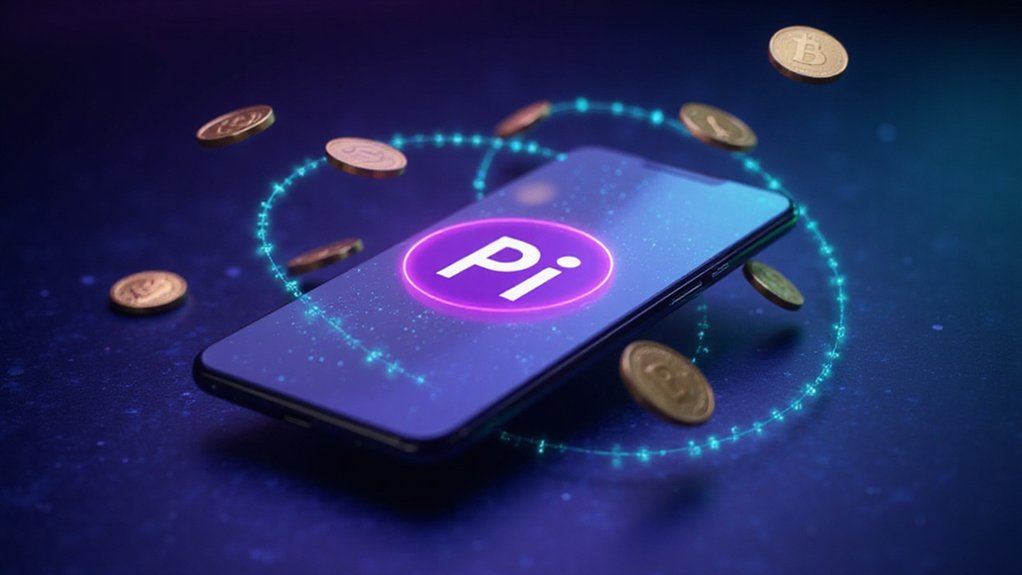Pi Network represents a distinctive mobile-first cryptocurrency approach launched by Stanford graduates in 2019. Its “social mining” mechanism—requiring merely a daily app tap—has attracted millions globally through an accessible alternative to resource-intensive mining operations. The ecosystem employs Stellar Consensus Protocol with defined roles for miners, nodes, and contributors, while embedding community engagement through security circles. Despite ambitious claims of democratizing digital currency, Pi’s revolutionary potential remains largely theoretical until full marketplace implementation materializes.

The Pi Network—a brainchild of Stanford graduates with ambitions that extend far beyond conventional cryptocurrency paradigms—has emerged as a potential disruptor in an industry already characterized by disruption.
Launched in 2019, this novel ecosystem represents a significant departure from the energy-intensive mining operations that have come to define cryptocurrencies like Bitcoin, offering instead a mobile-first approach that democratizes access to digital currency creation.
Unlike its predecessors, which demand substantial computational resources (and consequently, electricity consumption that would make even the most carbon-neutral enthusiast wince), Pi Network operates through what it terms a “social mining” mechanism.
The elegance of Pi’s social mining lies not in computational might, but in collective human participation—a digital revolution powered by taps, not watts.
Users participate simply by tapping a button daily—a process requiring about as much energy as sending a text message—while building referral teams to enhance their mining efficiency.
This elegantly simple system has attracted tens of millions of participants globally, many of whom had previously been excluded from cryptocurrency participation due to hardware limitations.
The network’s architecture revolves around clearly defined roles within its ecosystem.
Miners (who are, essentially, any smartphone owner willing to open an app daily) form the foundation, while contributors expand the network through invitations.
Nodes validate transactions, creating a symbiotic relationship that theoretically secures the blockchain without the environmental impact that has become cryptocurrency’s albatross¹.
While not currently offering traditional staking options, Pi Network’s structure resembles some aspects of the proof-of-stake consensus that has become increasingly popular in the cryptocurrency space.
The network implements the Stellar Consensus Protocol for exceptional energy efficiency compared to traditional proof-of-work systems.
Community engagement forms the cornerstone of Pi’s strategy, with users participating in security circles and network discussions—a stark contrast to the often-opaque operations of traditional financial institutions.
This social layer isn’t merely window dressing; it functions as both security mechanism and growth engine.
Pi’s ultimate vision transcends mere currency creation, aiming instead to establish a decentralized economy where value isn’t concentrated among early adopters or institutional investors.
While skeptics might question whether such idealistic ambitions can withstand market realities, the network’s mobile accessibility positions it uniquely in regions where advanced mining hardware remains financially untenable.
The platform’s innovative crowd-scaled KYC solution ensures user identity verification while maintaining the network’s commitment to broad accessibility and security.
Whether Pi will ultimately fulfill its revolutionary potential remains, like many aspects of the cryptocurrency landscape, an open question.
¹The environmental impact of traditional cryptocurrency mining continues to draw criticism from regulatory bodies worldwide.
Frequently Asked Questions
When Will Pi Network Be Available for Trading?
Pi Network remains in a peculiar trading purgatory as of May 2025.
Despite advancing to Open Mainnet and securing the Banxa integration (with its 10 million token acquisition), widespread trading on major exchanges remains elusive.
Hints of a potential Binance listing mid-May created temporary excitement, but concrete confirmation is lacking.
While price predictions range from $0.76 to $3.59, Pi’s actual market debut continues to drift in the nebulous domain of “soon”—a timeline crypto veterans know all too well.
How Much Will Pi Coins Be Worth Initially?
Pi cryptocurrency initially debuted on exchanges at $2 per Pi, though it quickly fell below $1 before rebounding to approximately $1.6.
The current trading range hovers around $0.78-$0.79, with substantial daily volume of roughly $500 million.
Notably, this market reality stands in stark contrast to community-established “consensus values,” which ambitiously ranged from $500 to $1,000 per Pi—with one particularly astronomical proposal suggesting $314,159 per token (π × 100,000, naturally).
Is Pi Network a Legitimate Cryptocurrency or a Scam?
Pi Network occupies a peculiar liminal space between legitimacy and skepticism.
While not definitively a scam (it employs real blockchain technology and has verified millions of users), significant red flags persist—notably its years-long “pre-launch” state, absence from major exchanges, and referral-heavy structure.
The project’s technical foundation appears sound, yet the prolonged inability to demonstrate tangible value or trading capabilities leaves Pi in cryptocurrency purgatory: neither confirmed legitimate nor conclusively fraudulent.
Can I Mine Pi Without Using My Mobile Data?
Pi mining requires minimal mobile data—just enough to initiate the 24-hour mining session (comparable to sending a text message). Once activated, the mining process continues offline in the background without requiring additional data until the next verification cycle.
Users in data-constrained environments can employ a “connect-verify-disconnect” approach, utilizing Wi-Fi where available to start sessions before returning to offline operation.
This efficiency makes Pi uniquely accessible in regions with limited connectivity.
How Does Pi Network Ensure User Data Privacy?
Pi Network safeguards user privacy through multiple intersecting security frameworks.
Its end-to-end encryption protects data transmission and storage, while the decentralized KYC process maintains identity verification without compromising personal information.
Users retain granular control over their data sharing preferences—an increasingly rare commodity in today’s digital landscape.
The network’s blockchain architecture inherently preserves transactional privacy, complemented by robust compliance measures and regular security audits that, remarkably, don’t undermine its privacy-centric ethos.









